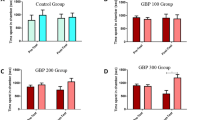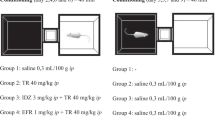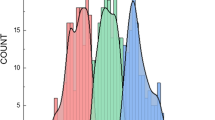Abstract
Rationale
Fendiline is a GABAB receptor-positive allosteric modulator and L-type Ca2+ channel blocker that is safe for human use. Based on these pharmacological properties, fendiline may be useful to disrupt associative memories that can drive relapse to drug use in drug-addicted individuals
Objective
The current study evaluated the potential of fendiline to inhibit the maintenance and expression of learned associations between methamphetamine (meth) and an environmental context using conditioned place preference (CPP) in rats, to model for the associative learning that occurs during drug abuse by humans
Methods
Following meth conditioning (1 mg/kg), fendiline (5 mg/kg) was administered at various post-conditioning times to ascertain if there was a temporal window during which fendiline would be effective.
Results
Two once-daily injections of fendiline did not influence the maintenance of CPP regardless of the post-conditioning treatment time while 10 once-daily fendiline treatments inhibited CPP maintenance (p < 0.05). Fendiline administered immediately prior to the CPP test inhibited expression of meth-induced CPP in rats with a fendiline treatment history of 10 once-daily injections (p < 0.05) or those that received two injections that corresponded to the last 2 days of the 10-day treatment (p < 0.05). Fendiline did not produce preference or aversion on its own, nor did it alter motivated motor behavior.
Conclusion
Maintenance and expression of meth CPP is mitigated by repeated fendiline treatments when administered during the days that precede CPP testing. Reduction in the significance of meth-associated cues can reduce relapse; therefore, fendiline may be of value for addiction therapy in abstinent, meth-addicted humans.





Similar content being viewed by others
References
Alberini CM, Milekic MH, Tronel S (2006) Mechanisms of memory stabilization and de-stabilization. Cell Mol Life Sci 63:999–1008
Ameisen O (2005) Complete and prolonged suppression of symptoms and consequences of alcohol-dependence using high-dose baclofen: a self-case report of a physician. Alcohol Alcohol 40:147–150
Arai S, Takuma K, Mizoguchi H, Ibi D, Nagai T, Kamei H, Kim HC, Yamada K (2009) GABAB receptor agonist baclofen improves methamphetamine-induced cognitive deficit in mice. Eur J Pharmacol 602:101–104
Bailey CH, Kandel ER, Si K (2004) The persistence of long-term memory: a molecular approach to self-sustaining changes in learning-induced synaptic growth. Neuron 44:49–57
Bartoletti M, Gubellini C, Ricci F, Gaiardi M (2004) The GABAB agonist baclofen blocks the expression of sensitisation to the locomotor stimulant effect of amphetamine. Behav Pharmacol 15:397–401
Bartoletti M, Gubellini C, Ricci F, Gaiardi M (2005) Baclofen blocks the development of sensitization to the locomotor stimulant effect of amphetamine. Behav Pharmacol 16:553–558
Bayer R, Mannhold R (1987) Fendiline: a review of its basic pharmacological and clinical properties. Pharmatherapeutica 5:103–136
Berke JD, Hyman SE (2000) Addiction, dopamine, and the molecular mechanisms of memory. Neuron 25:515–532
Biala G (2003) Calcium channel antagonists suppress nicotine-induced place preference and locomotor sensitization in rodents. Pol J Pharmacol 55:327–335
Biala G, Budzynska B (2008) Calcium-dependent mechanisms of the reinstatement of nicotine-conditioned place preference by drug priming in rats. Pharmacol Biochem Behav 89:116–125
Biala G, Kruk-Slomka M, Jozwiak K (2013) Influence of acute or chronic calcium channel antagonists on the acquisition and consolidation of memory and nicotine-induced cognitive effects in mice. Naunyn Schmiedebergs Arch Pharmacol 386:651–664
Bowery NG (1993) GABAB receptor pharmacology. Annu Rev Pharmacol Toxicol 33:109–147
Brebner K, Childress AR, Roberts DC (2002) A potential role for GABA(B) agonists in the treatment of psychostimulant addiction. Alcohol Alcohol 37:478–484
Brebner K, Ahn S, Phillips AG (2005) Attenuation of d-amphetamine self-administration by baclofen in the rat: behavioral and neurochemical correlates. Psychopharmacology (Berlin) 177:409–417
Brenhouse HC, Andersen SL (2008) Delayed extinction and stronger reinstatement of cocaine conditioned place preference in adolescent rats, compared to adults. Behav Neurosci 122:460–465
Brown EE, Robertson GS, Fibiger HC (1992) Evidence for conditional neuronal activation following exposure to a cocaine-paired environment: role of forebrain limbic structures. J Neurosci 12:4112–4121
Calcagnetti DJ, Schechter MD (1994) Nicotine place preference using the biased method of conditioning. Prog Neuropsychopharmacol Biol Psychiatry 18:925–933
Castellano C, Brioni JD, Nagahara AH, McGaugh JL (1989) Post-training systemic and intra-amygdala administration of the GABA-B agonist baclofen impairs retention. Behav Neural Biol 52:170–179
Chappell WR, Mordenti J (1991) Extrapolation of toxicological and pharmacological data from animals to humans. In: Testa B (ed) Drug Research. Academic Press, New York, pp 1–116
Chen Y, Phillips K, Minton G, Sher E (2005) GABA(B) receptor modulators potentiate baclofen-induced depression of dopamine neuron activity in the rat ventral tegmental area. Br J Pharmacol 144:926–932
Childress AR, Mozley PD, McElgin W, Fitzgerald J, Reivich M, O’Brien CP (1999) Limbic activation during cue-induced cocaine craving. Am J Psychiatry 156:11–18
Childress AR, Ehrman RN, Wang Z, Li Y, Sciortino N, Hakun J, Jens W, Suh J, Listerud J, Marquez K, Franklin T, Langleben D, Detre J, O’Brien CP (2008) Prelude to passion: limbic activation by “unseen” drug and sexual cues. PLoS One 3:e1506
Childs E, de Wit H (2009) Amphetamine-induced place preference in humans. Biol Psychiatry 65:900–904
Cousins MS, Stamat HM, de Wit H (2001) Effects of a single dose of baclofen on self-reported subjective effects and tobacco smoking. Nicotine Tob Res 3:123–129
Cryan JF, Kelly PH, Chaperon F, Gentsch C, Mombereau C, Lingenhoehl K, Froestl W, Bettler B, Kaupmann K, Spooren WP (2004) Behavioral characterization of the novel GABAB receptor-positive modulator GS39783 (N,N′-dicyclopentyl-2-methylsulfanyl-5-nitro-pyrimidine-4,6-diamine): anxiolytic-like activity without side effects associated with baclofen or benzodiazepines. J Pharmacol Exp Ther 310:952–963
Cunningham CL, Ferree NK, Howard MA (2003) Apparatus bias and place conditioning with ethanol in mice. Psychopharmacology (Berl) 170:409–422
de Macedo GC, Kawakami SE, Vignoli T, Sinigaglia-Coimbra R, Suchecki D (2013) The influence of orexins on ethanol-induced behavioral sensitization in male mice. Neurosci Lett. doi:10.1016/j.neulet.2013.07.010:
DeMarco A, Dalal RM, Pai J, Aquilina SD, Mullapudi U, Hammel C, Kothari SK, Kahanda M, Liebling CN, Patel V, Schiffer WK, Brodie JD, Dewey SL (2009) Racemic gamma vinyl-GABA (R, S-GVG) blocks methamphetamine-triggered reinstatement of conditioned place preference. Synapse 63:87–94
Ehrman RN, Robbins SJ, Childress AR, O’Brien CP (1992) Conditioned responses to cocaine-related stimuli in cocaine abuse patients. Psychopharmacology (Berl) 107:523–529
Fattore L, Spano MS, Cossu G, Scherma M, Fratta W, Fadda P (2009) Baclofen prevents drug-induced reinstatement of extinguished nicotine-seeking behaviour and nicotine place preference in rodents. Eur Neuropsychopharmacol 19:487–498
Filip M, Frankowska M (2007) Effects of GABA(B) receptor agents on cocaine priming, discrete contextual cue and food induced relapses. Eur J Pharmacol 571:166–173
Filip M, Frankowska M, Przegalinski E (2007) Effects of GABA(B) receptor antagonist, agonists and allosteric positive modulator on the cocaine-induced self-administration and drug discrimination. Eur J Pharmacol 574:148–157
Ford KA, Wolf ME, Hu XT (2009) Plasticity of L-type Ca2+ channels after cocaine withdrawal. Synapse 63:690–697
Frankowska M, Wydra K, Faron-Gorecka A, Zaniewska M, Kusmider M, Dziedzicka-Wasylewska M, Filip M (2008) Neuroadaptive changes in the rat brain GABA(B) receptors after withdrawal from cocaine self-administration. Eur J Pharmacol 599:58–64
Gjoni T, Urwyler S (2008) Receptor activation involving positive allosteric modulation, unlike full agonism, does not result in GABAB receptor desensitization. Neuropharmacology 55:1293–1299
Gjoni T, Desrayaud S, Imobersteg S, Urwyler S (2006) The positive allosteric modulator GS39783 enhances GABA(B) receptor-mediated inhibition of cyclic AMP formation in rat striatum in vivo. J Neurochem 96:1416–1422
Guo N, Garcia MM, Harlan RE (2008) A morphine-paired environment alters c-Fos expression in the forebrain of rats displaying conditioned place preference or aversion. Behav Neurosci 122:1078–1086
Halbout B, Quarta D, Valerio E, Heidbreder CA, Hutcheson DM (2011) The GABA-B positive modulator GS39783 decreases psychostimulant conditioned-reinforcement and conditioned-reward. Addict Biol 16:416–427
Haney M, Hart CL, Foltin RW (2006) Effects of baclofen on cocaine self-administration: opioid- and nonopioid-dependent volunteers. Neuropsychopharmacology 31:1814–1821
Herrold AA, Voigt RM, Napier TC (2013) mGluR5 is necessary for maintenance of methamphetamine-induced associative learning. Eur Neuropsychopharmacol 23:691–696
Hotsenpiller G, Wolf ME (2002) Extracellular glutamate levels in prefrontal cortex during the expression of associative responses to cocaine related stimuli. Neuropharmacology 43:1218–1229
Hotsenpiller G, Giorgetti M, Wolf ME (2001) Alterations in behaviour and glutamate transmission following presentation of stimuli previously associated with cocaine exposure. Eur J Neurosci 14:1843–1855
Hu XT (2007) Cocaine withdrawal and neuro-adaptations in ion channel function. Mol Neurobiol 35:95–112
Jayaram P, Steketee JD (2005) Effects of cocaine-induced behavioural sensitization on GABA transmission within rat medial prefrontal cortex. Eur J Neurosci 21:2035–2039
Kelley AE (2004) Memory and addiction: shared neural circuitry and molecular mechanisms. Neuron 44:161–179
Kerr DI, Ong J, Puspawati NM, Prager RH (2002) Arylalkylamines are a novel class of positive allosteric modulators at GABA(B) receptors in rat neocortex. Eur J Pharmacol 451:69–77
Kilts CD, Gross RE, Ely TD, Drexler KP (2004) The neural correlates of cue-induced craving in cocaine-dependent women. Am J Psychiatry 161:233–241
Kozlovskii VL (1997) The relationship between anticonvulsant and anti-anxiety effects of calcium channel blockers. Eksp Klin Farmakol 60:19–22
Kozlovskii VL, Mosin AE, Ivakina LV (1996) The effect of the subchronic administration of calcium-channel blockers on CNS excitability. Eksp Klin Farmakol 59:14–16
Kukovetz WR, Brunner F, Beubler E, Weyhenmeyer R, Lohaus R, Grob M, Mayer D (1982) Single dose pharmacokinetics of fendiline in humans. Eur J Drug Metab Pharmacokinet 7:105–110
Kurokawa K, Mizuno K, Ohkuma S (2012) Possible involvement of type 1 inositol 1,4,5-trisphosphate receptors up-regulated by dopamine D1 and D2 receptors in mouse nucleus accumbens neurons in the development of methamphetamine-induced place preference. Neuroscience 227:22–29
Kushner SA, Unterwald EM (2001) Chronic cocaine administration decreases the functional coupling of GABA(B) receptors in the rat ventral tegmental area as measured by baclofen-stimulated 35S-GTPgammaS binding. Life Sci 69:1093–1102
Li SM, Yin LL, Ren YH, Pan LS, Zheng JW (2001) GABA(B) receptor agonist baclofen attenuates the development and expression of d-methamphetamine-induced place preference in rats. Life Sci 70:349–356
Lobina C, Carai MA, Froestl W, Mugnaini C, Pasquini S, Corelli F, Gessa GL, Colombo G (2011) Activation of the GABA(B) receptor prevents nicotine-induced locomotor stimulation in mice. Front Psychiatry 2:76
Maksimenko EI, Zaitsev AA, Ailamazian EK, Ignatov I, Mikhailov AA (1997) Comparison of the tocolytic and hemodynamic effects of calcium channel blockers in pregnant rats. Eksp Klin Farmakol 60:25–27
Martin-Iverson MT, Reimer AR (1994) Effects of nimodipine and/or haloperidol on the expression of conditioned locomotion and sensitization to cocaine in rats. Psychopharmacology (Berl) 114:315–320
Masur J, dos Santos HM (1988) Response variability of ethanol-induced locomotor activation in mice. Psychopharmacology (Berl) 96:547–550
McDaid J, Graham MP, Napier TC (2006) Methamphetamine-induced sensitization differentially alters pCREB and DeltaFosB throughout the limbic circuit of the mammalian brain. Mol Pharmacol 70:2064–2074
McGregor C, Srisurapanont M, Jittiwutikarn J, Laobhripatr S, Wongtan T, White JM (2005) The nature, time course and severity of methamphetamine withdrawal. Addiction 100:1320–1329
Mizoguchi H, Yamada K (2011) Pharmacologic treatment with GABA(B) receptor agonist of methamphetamine-induced cognitive impairment in mice. Curr Neuropharmacol 9:109–112
Mott DD, Lewis DV (1994) The pharmacology and function of central GABAB receptors. Int Rev Neurobiol 36:97–223
Nasif FJ, Hu XT, White FJ (2005) Repeated cocaine administration increases voltage-sensitive calcium currents in response to membrane depolarization in medial prefrontal cortex pyramidal neurons. J Neurosci 25:3674–3679
Nawrath H, Klein G, Rupp J, Wegener JW, Shainberg A (1998) Open state block by fendiline of L-type Ca++ channels in ventricular myocytes from rat heart. J Pharmacol Exp Ther 285:546–552
Nestler EJ (2001) Molecular basis of long-term plasticity underlying addiction. Nat Rev Neurosci 2:119–128
Nomikos GG, Spyraki C (1988) Cocaine-induced place conditioning: importance of route of administration and other procedural variables. Psychopharmacology (Berlin) 94:119–125
Nordahl TE, Salo R, Natsuaki Y, Galloway GP, Waters C, Moore CD, Kile S, Buonocore MH (2005) Methamphetamine users in sustained abstinence: a proton magnetic resonance spectroscopy study. Arch Gen Psychiatry 62:444–452
Ong J, Kerr DI (2005) Clinical potential of GABAB receptor modulators. CNS Drug Rev 11:317–334
Ong J, Parker DA, Marino V, Kerr DI, Puspawati NM, Prager RH (2005) 3-Chloro,4-methoxyfendiline is a potent GABA(B) receptor potentiator in rat neocortical slices. Eur J Pharmacol 507:35–42
Paolone G, Botreau F, Stewart J (2009) The facilitative effects of D-cycloserine on extinction of a cocaine-induced conditioned place preference can be long lasting and resistant to reinstatement. Psychopharmacology (Berlin) 202:403–409
Paterson NE, Vlachou S, Guery S, Kaupmann K, Froestl W, Markou A (2008) Positive modulation of GABA(B) receptors decreased nicotine self-administration and counteracted nicotine-induced enhancement of brain reward function in rats. J Pharmacol Exp Ther 326:306–314
Porrino LJ, Hampson RE, Opris I, Deadwyler SA (2013) Acute cocaine induced deficits in cognitive performance in rhesus macaque monkeys treated with baclofen. Psychopharmacology (Berlin) 225:105–114
Ranaldi R, Poeggel K (2002) Baclofen decreases methamphetamine self-administration in rats. Neuroreport 13:1107–1110
Rebec GV, Sun W (2005) Neuronal substrates of relapse to cocaine-seeking behavior: role of prefrontal cortex. J Exp Anal Behav 84:653–666
Rezayof A, Ghandipour M, Nazari-Serenjeh F (2012) Effect of co-injection of arachydonilcyclopropylamide and ethanol on conditioned place preference in rats. Physiol Behav 107:301–308
Rhodes JS, Ryabinin AE, Crabbe JC (2005) Patterns of brain activation associated with contextual conditioning to methamphetamine in mice. Behav Neurosci 119:759–771
Rose ME, Grant JE (2008) Pharmacotherapy for methamphetamine dependence: a review of the pathophysiology of methamphetamine addiction and the theoretical basis and efficacy of pharmacotherapeutic interventions. Ann Clin Psychiatry 20:145–155
Shoptaw S, Yang X, Rotheram-Fuller EJ, Hsieh YC, Kintaudi PC, Charuvastra VC, Ling W (2003) Randomized placebo-controlled trial of baclofen for cocaine dependence: preliminary effects for individuals with chronic patterns of cocaine use. J Clin Psychiatry 64:1440–1448
Simon SL, Dean AC, Cordova X, Monterosso JR, London ED (2010) Methamphetamine dependence and neuropsychological functioning: evaluating change during early abstinence. J Stud Alcohol Drugs 71:335–344
Smith MA, Yancey DL, Morgan D, Liu Y, Froestl W, Roberts DC (2004) Effects of positive allosteric modulators of the GABAB receptor on cocaine self-administration in rats. Psychopharmacology (Berlin) 173:105–111
Steiner MA, Lecourt H, Strasser DS, Brisbare-Roch C, Jenck F (2011) Differential effects of the dual orexin receptor antagonist almorexant and the GABA(A)-alpha1 receptor modulator zolpidem, alone or combined with ethanol, on motor performance in the rat. Neuropsychopharmacology 36:848–856
Suzuki T, Shiozaki Y, Masukawa Y, Misawa M (1992) Effects of calcium antagonists on the cocaine- and methamphetamine-induced conditioned place preference. Arukoru Kenkyuto Yakubutsu Ison 27:81–90
Swartzwelder HS, Tilson HA, McLamb RL, Wilson WA (1987) Baclofen disrupts passive avoidance retention in rats. Psychopharmacology (Berlin) 92:398–401
Tripathi O, Schreibmayer W, Tritthart HA (1993) Fendiline inhibits L-type calcium channels in guinea-pig ventricular myocytes: a whole-cell patch-clamp study. Br J Pharmacol 108:865–869
Tzschentke TM (1998) Measuring reward with the conditioned place preference paradigm: a comprehensive review of drug effects, recent progress and new issues. Prog Neurobiol 56:613–672
Urwyler S, Gjoni T, Kaupmann K, Pozza MF, Mosbacher J (2004) Selected amino acids, dipeptides and arylalkylamine derivatives do not act as allosteric modulators at GABAB receptors. Eur J Pharmacol 483:147–153
Urwyler S, Gjoni T, Koljatic J, Dupuis DS (2005) Mechanisms of allosteric modulation at GABAB receptors by CGP7930 and GS39783: effects on affinities and efficacies of orthosteric ligands with distinct intrinsic properties. Neuropharmacology 48:343–353
US Department of Health and Human Services (2005) Guidance for industry on estimating the maximum safe starting dose in initial clinical trials for therapeutics in adult healthy volunteers. p 42346
Voigt RM, Herrold AA, Napier TC (2011a) Baclofen facilitates the extinction of methamphetamine-induced conditioned place preference in rats. Behav Neurosci 125:261–267
Voigt RM, Herrold AA, Riddle JL, Napier TC (2011b) Administration of GABA(B) receptor positive allosteric modulators inhibit the expression of previously established methamphetamine-induced conditioned place preference. Behav Brain Res 216:419–423
Wang H, Hu Y, Tsien JZ (2006) Molecular and systems mechanisms of memory consolidation and storage. Prog Neurobiol 79:123–135
Weyhenmeyer R, Fenzl E, Apecechea M, Rehm KD, Dyde CJ, Johnson KJ, Friedel R (1987) Tolerance and pharmacokinetics of oral fendiline. Arzneimittelforschung 37:58–62
Xi ZX, Gardner EL (2008) Hypothesis-driven medication discovery for the treatment of psychostimulant addiction. Curr Drug Abuse Rev 1:303–327
Yu YJ, Chang CH, Gean PW (2013) AMPA receptor endocytosis in the amygdala is involved in the disrupted reconsolidation of methamphetamine-associated contextual memory. Neurobiol Learn Mem 103:72–81
Zarrindast MR, Shamsi T, Azarmina P, Rostami P, Shafaghi B (2004) GABAergic system and imipramine-induced impairment of memory retention in rats. Eur Neuropsychopharmacol 14:59–64
Zhang K, Tarazi FI, Campbell A, Baldessarini RJ (2000) GABA(B) receptors: altered coupling to G-proteins in rats sensitized to amphetamine. Neuroscience 101:5–10
Zhang Y, Loonam TM, Noailles PA, Angulo JA (2001) Comparison of cocaine- and methamphetamine-evoked dopamine and glutamate overflow in somatodendritic and terminal field regions of the rat brain during acute, chronic, and early withdrawal conditions. Ann N Y Acad Sci 937:93–120
Zombeck JA, Chen GT, Johnson ZV, Rosenberg DM, Craig AB, Rhodes JS (2008) Neuroanatomical specificity of conditioned responses to cocaine versus food in mice. Physiol Behav 93:637–650
Zorick T, Nestor L, Miotto K, Sugar C, Hellemann G, Scanlon G, Rawson R, London ED (2010) Withdrawal symptoms in abstinent methamphetamine-dependent subjects. Addiction 105:1809–1818
Author information
Authors and Affiliations
Corresponding author
Rights and permissions
About this article
Cite this article
Voigt, R.M., Riddle, J.L. & Napier, T.C. Effect of fendiline on the maintenance and expression of methamphetamine-induced conditioned place preference in Sprague–Dawley rats. Psychopharmacology 231, 2019–2029 (2014). https://doi.org/10.1007/s00213-013-3347-7
Received:
Accepted:
Published:
Issue Date:
DOI: https://doi.org/10.1007/s00213-013-3347-7




